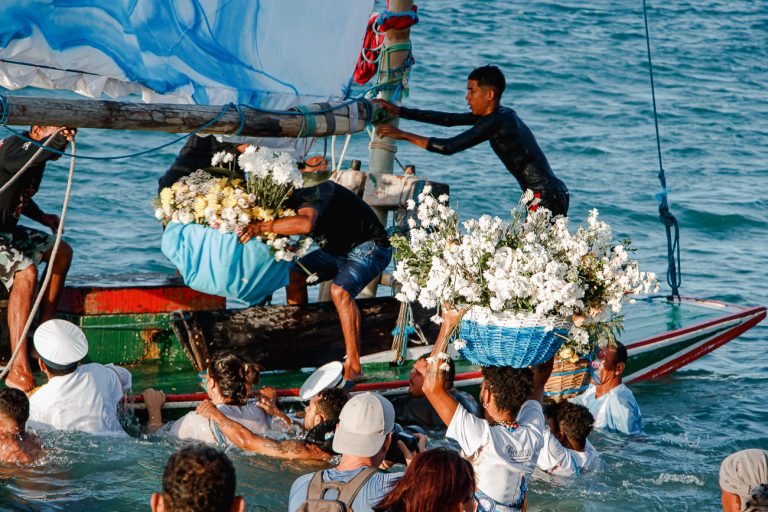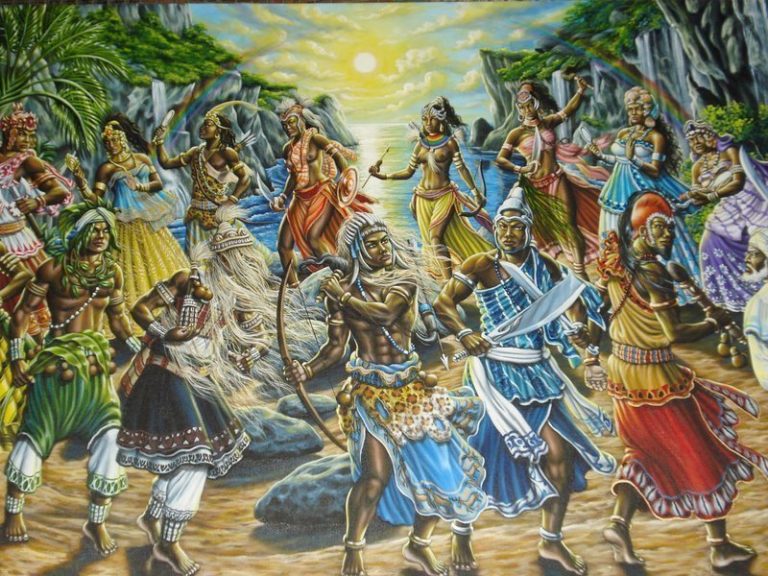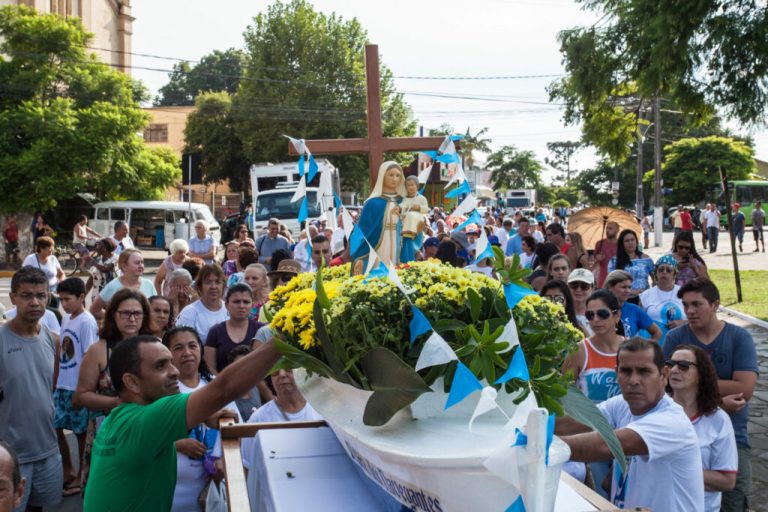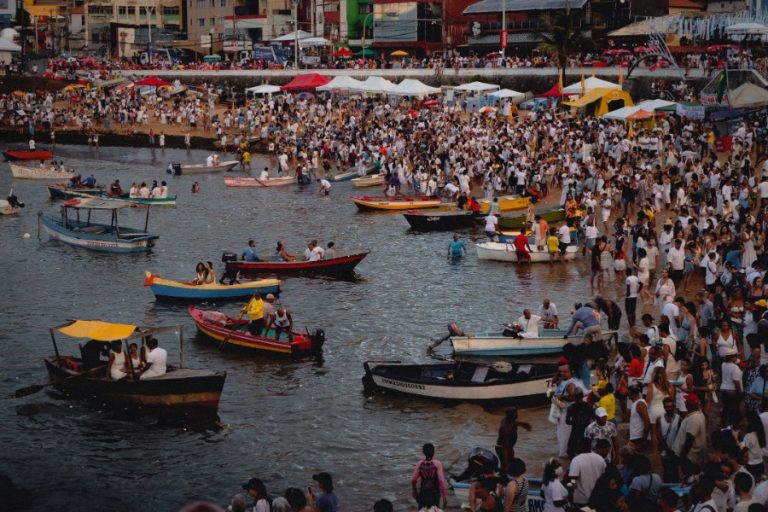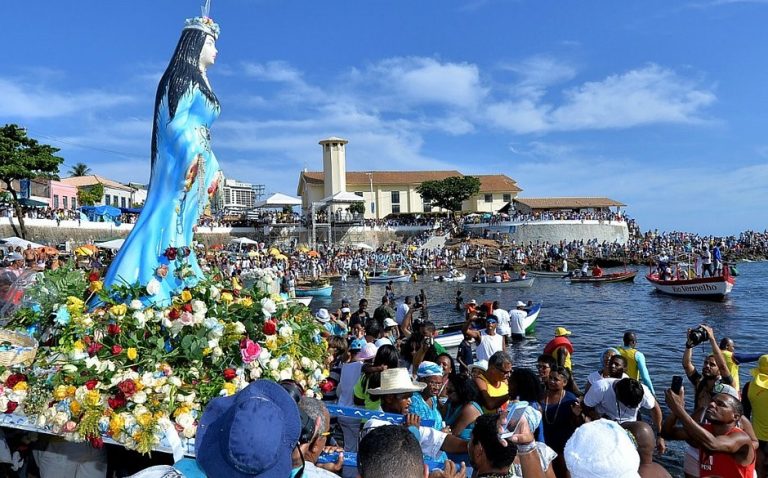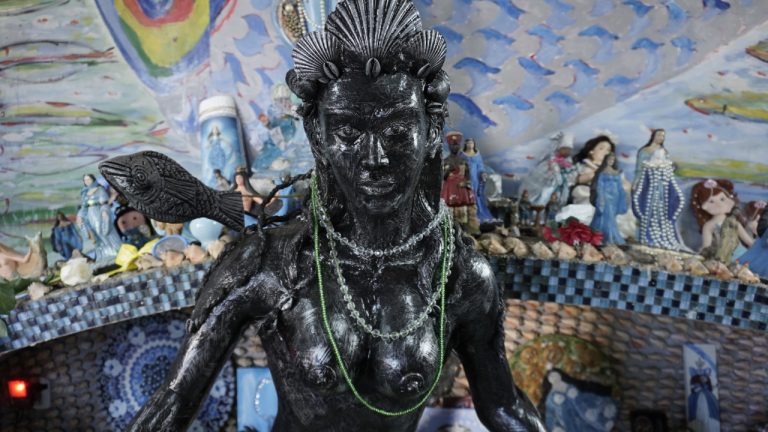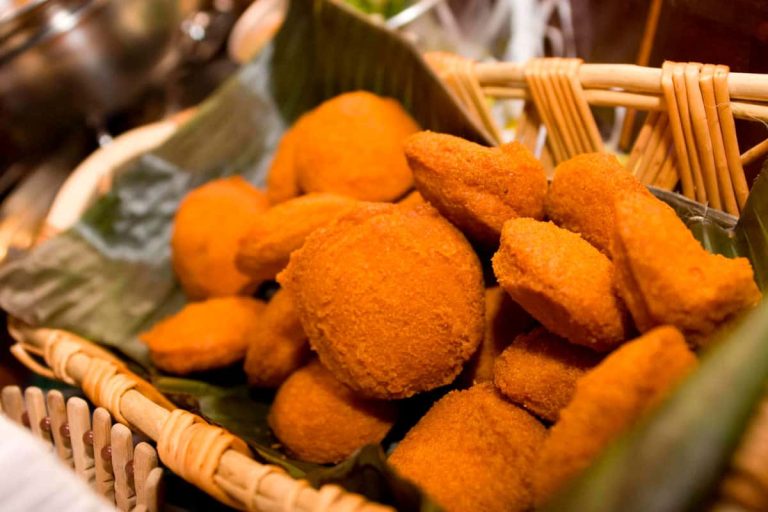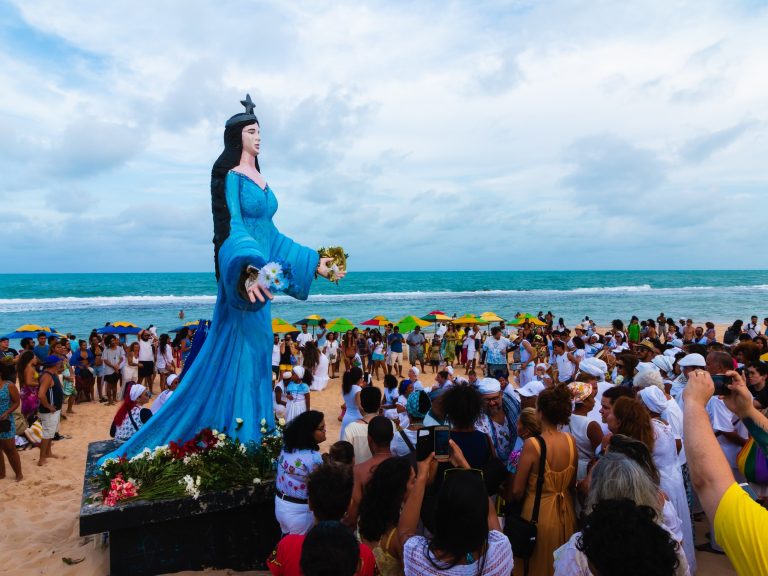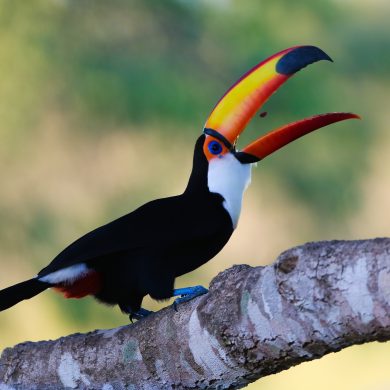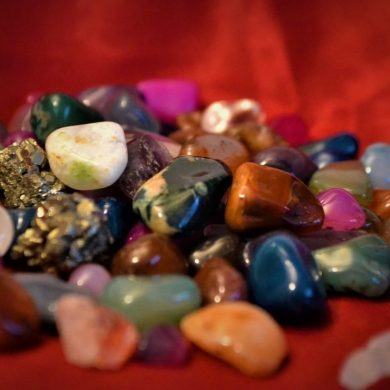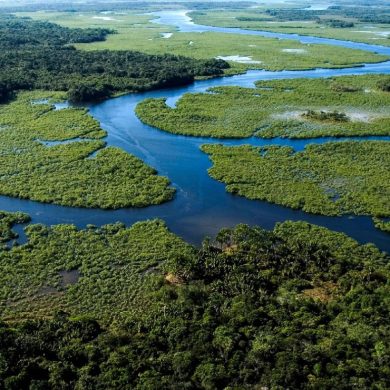Half mermaid, half hermaphrodite creature, depending on the region, Lemanja is celebrated on the beaches of Brazil on February 2. This day is essential for those curious to delve into one of Brazil’s most practiced religions: Candomblé. The beaches of Salvador de Bahia are particularly significant, where the festival of Iemanja (Dia de Iemanja) is observed, honoring the mother goddess of all Candomblé saints. This celebration is not only a religious rite but also a vibrant cultural event that draws people from all walks of life.
February 2: Festival of the Ocean Goddess in Bahia and Throughout Brazil
Candomblé is a deeply rooted syncretic religion, blending African beliefs with Catholicism, brought to Brazil by enslaved Africans. The Portuguese colonizers’ efforts to convert Africans to Catholicism led to a fusion of African deities with Catholic saints. Iemanja, the mother of all Orixás (divinities associated with elements of nature such as water, fire, sea, and forest), became associated with the Virgin Mary. This syncretism helped preserve the African spiritual traditions while allowing them to coexist with Catholic practices.
The Origin and Significance of Iemanja
Iemanja is venerated as the goddess of the sea, water in general, and particularly of pregnant women. Her worship is deeply rooted in the coastal regions of Brazil, where offerings are made to her in the belief that she will grant blessings, protection, and fertility. The celebration of Iemanja on February 2 is a culmination of a series of rituals and traditions that have been passed down through generations. It is a day when people from all over Brazil, and indeed the world, come together to pay homage to the ocean goddess.
Iemanja’s importance in Candomblé cannot be overstated. As the protector of fishermen and the patroness of childbirth, she is a central figure in the pantheon of Orixás. Her symbols, such as seashells and fish, represent her dominion over the ocean and all its creatures. In Candomblé mythology, Iemanja is often depicted as a beautiful woman with long flowing hair, dressed in blue and white, colors that symbolize the sea and purity. She is also considered the mother of many other Orixás, making her a maternal figure of great reverence and respect.
Honoring Iemanja
The goddess Iemanja is honored in various ways, with one of the most famous practices being the New Year’s Eve offerings on the beaches. As the clock strikes midnight, thousands of people gather on the shore, each person carrying a small boat or basket filled with gifts such as flowers, perfumes, soaps, and jewelry. These offerings are cast into the sea, symbolizing their prayers, wishes, and gratitude to Iemanja. The tradition is a powerful display of faith, community, and the deep connection between the people and the sea.
These New Year’s celebrations are just a precursor to the main event on February 2. On this day, the beaches are transformed into a sea of white as worshippers dress in white garments to symbolize purity and peace. The streets leading to the beach are filled with processions, music, and dance, creating an atmosphere of festivity and reverence. The participants, regardless of their social or economic status, come together to celebrate their devotion to Iemanja, demonstrating the inclusive nature of Candomblé.
February 2 in Bahia
The official festival, Dia de Iemanja, takes place on February 2, centered on the beaches of Rio Vermelho in Salvador de Bahia. This area is historically significant as the point where slave ships from Africa docked, making it a sacred space for the Candomblé tradition. Salvador is considered the heart of Candomblé in Brazil, with an estimated 3 million practitioners. The festival’s origins date back to the 1920s, but it was officially institutionalized in 1960, becoming a significant cultural and religious event.
From the early hours of February 2, the beaches of Rio Vermelho come alive with activity. Locals, dressed in white, make their way to the shore to make their offerings to Iemanja through priestesses known as “Mães de Santos.” These priestesses, along with “Pais de Santos” (fathers of the saints), conduct ceremonies in the traditional houses called “Terreiros.” As the day progresses, the beach transforms into a massive celebration of music, dance, and vibrant colors. The rhythmic beats of drums fill the air, accompanied by traditional songs that echo the calls of the Orixás.
The Ritual of the Offerings
Visitors and locals alike participate in the ritual of offering gifts to Iemanja. Small boats, or “balaio” laden with items such as flowers, candles, mirrors, perfumes, and jewelry are launched into the waves. This ritual is a poignant spectacle, symbolizing the hopes and dreams of those who come to honor the goddess. The sea, with its vastness and mystery, becomes a conduit for their prayers, carrying their wishes to Iemanja. The atmosphere is filled with a sense of unity, hope, and spiritual connection, as people dance, sing, and celebrate under the sun and stars.
The offerings are not just random objects; each has a specific significance. Flowers, especially white roses, symbolize purity and are a common offering. Perfumes and soaps represent the cleansing of the spirit and a fresh start. Jewelry and mirrors are luxury items that signify respect and admiration for the goddess. These offerings are carefully chosen and prepared, reflecting the deep respect and devotion of the worshippers.
A Cultural Experience
The Dia de Iemanja is more than just a religious ceremony; it is a profound cultural experience that reflects the rich heritage of Brazil’s Afro-Brazilian community. It brings together people from diverse backgrounds, transcending social and economic barriers. The festival is a testament to the resilience and creativity of the African descendants in Brazil, who have preserved their traditions and infused them with new meanings. The celebration is a vibrant tapestry of music, dance, cuisine, and spiritual rituals, creating an unforgettable experience for all who participate.
The Spiritual Significance
For many, the festival is a time of deep spiritual reflection and renewal. The offerings are not merely tokens; they are imbued with intentions, prayers, and dreams. The act of launching the balaio into the sea is a symbolic gesture of surrender and trust in the divine power of Iemanja. It is a moment of vulnerability, where people lay bare their hopes and fears, seeking the goddess’s blessings and protection. The rituals and ceremonies are conducted with great reverence, highlighting the profound spiritual bond between the devotees and the Orixás.
The spiritual atmosphere is palpable as the beach becomes a sacred space where the divine and human realms intersect. The rhythmic drumming and chanting create a trance-like state, allowing participants to connect deeply with the spiritual world. This connection is believed to bring healing, guidance, and blessings from Iemanja and the other Orixás. The festival serves as a powerful reminder of the enduring presence of African spirituality in Brazil and its significant influence on Brazilian culture.
The Role of Music and Dance
Music and dance are integral parts of the Dia de Iemanja celebrations. Traditional Candomblé songs, known as “pontos,” are sung in Yoruba, the language of the Orixás. These songs are accompanied by drums and other percussion instruments, creating a rhythmic and hypnotic sound that resonates with the participants. The music sets the tone for the ceremonies and rituals, guiding the movements and actions of the worshippers.
Dance is another vital component of the festival. Each Orixá has a specific dance associated with them, and during the celebrations, participants perform these dances to honor the deities. The dances are characterized by graceful and expressive movements that tell stories of the Orixás and their powers. For Iemanja, the dance is often fluid and flowing, mimicking the movement of the waves. The dancers, dressed in traditional attire, move in unison, creating a mesmerizing spectacle that captivates onlookers.
The Culinary Delights
No Brazilian celebration is complete without food, and the Dia de Iemanja is no exception. The festival is an opportunity to enjoy traditional Afro-Brazilian cuisine, which plays a significant role in the cultural identity of the community. Street vendors and local restaurants offer a variety of dishes that reflect the rich culinary heritage of Bahia. Popular dishes include “acarajé,” a deep-fried ball made from black-eyed peas and filled with shrimp, and “vatapá,” a creamy paste made from bread, shrimp, coconut milk, and palm oil.
These dishes are not only delicious but also carry cultural and religious significance. Acarajé, for example, is traditionally offered to Iansã, another Orixá, and is an essential part of Candomblé rituals. Sharing these foods during the festival fosters a sense of community and connection among participants, reinforcing the bonds of tradition and heritage.
A Must-See Festival
Just like the Lavagem do Bonfim or Carnival, the Dia de Iemanja is a spellbinding ritual not to be missed. It offers a unique opportunity to witness and participate in one of Brazil’s most authentic cultural and spiritual celebrations. For those who seek to understand and experience the heart of Brazil’s Afro-Brazilian culture, Salvador de Bahia during this time is the place to be. The festival is a vibrant blend of tradition, faith, and festivity, making it an enriching experience for travelers and cultural enthusiasts alike.
Whether you are a seasoned traveler or a curious newcomer, the Dia de Iemanja promises an unforgettable journey into the soul of Brazil. It is a celebration that transcends time and space, connecting people across generations and cultures in a shared celebration of life, hope, and the eternal bond with the divine. Don’t miss this extraordinary event if you’re in Brazil; it’s a true testament to the power of faith, community, and the enduring spirit of the Orixás.
The Dia de Iemanja is not just a festival; it is a living, breathing expression of Brazil’s rich cultural tapestry. It is an event where history, spirituality, and community come together in a powerful display of devotion and joy. For anyone looking to experience the true essence of Brazil, participating in the Dia de Iemanja is an opportunity to witness the country’s vibrant cultural heritage and the deep spiritual connections that define its people. This celebration of the goddess of the sea is a reminder of the enduring legacy of African traditions in Brazil and the powerful role they continue to play in shaping the nation’s identity.

